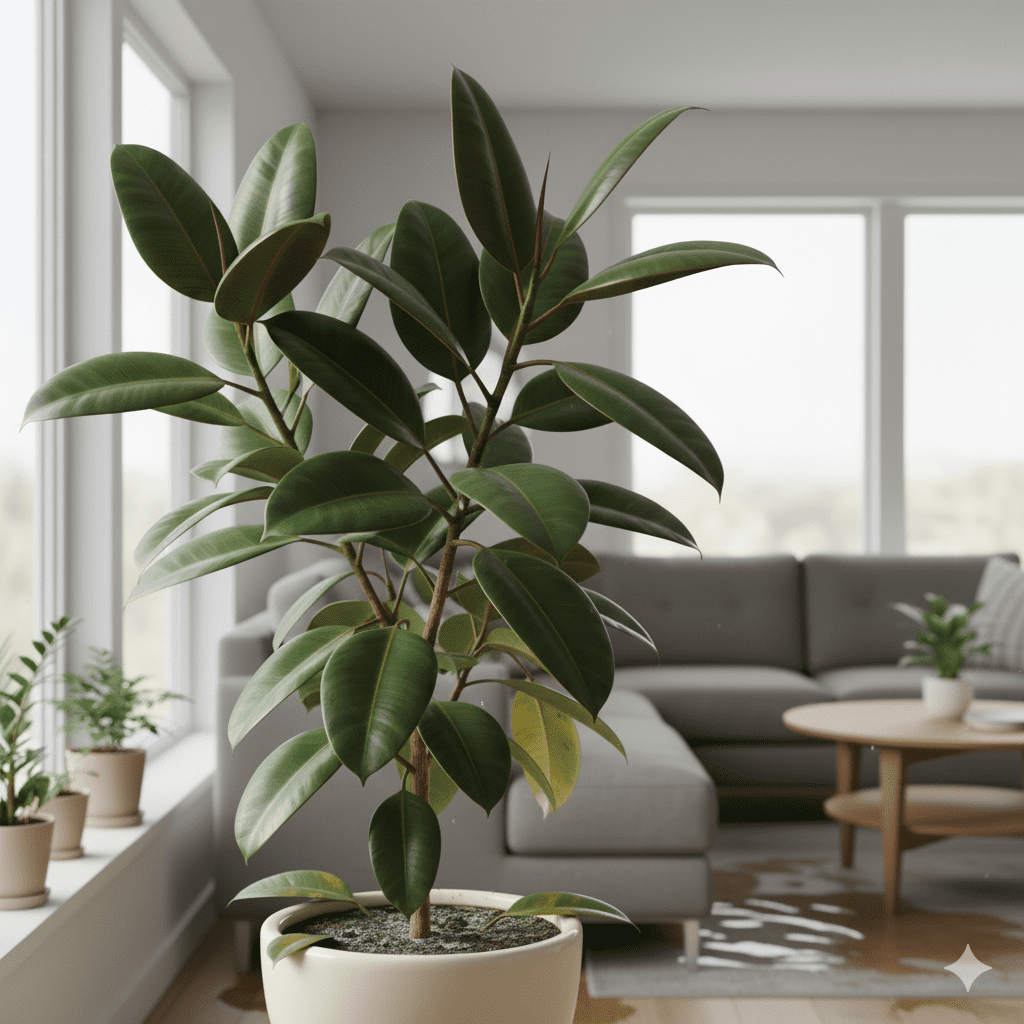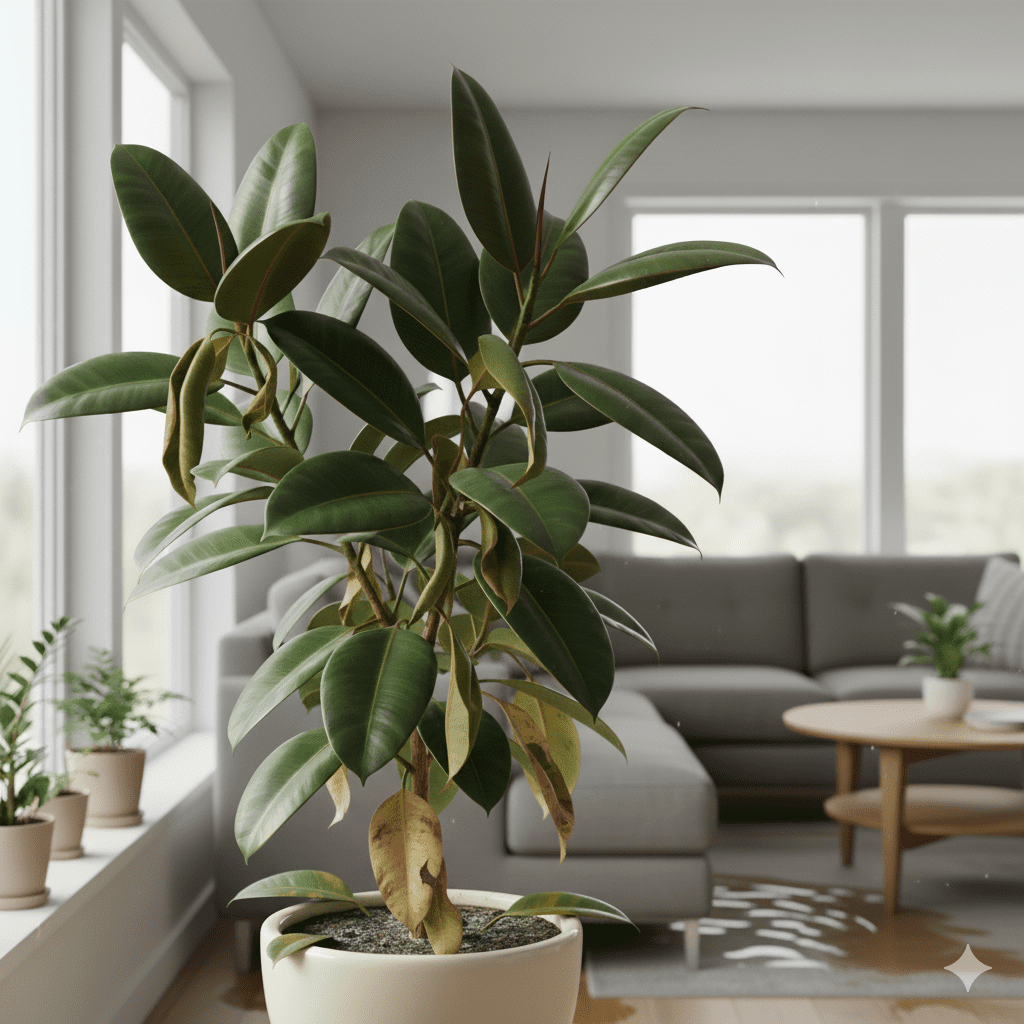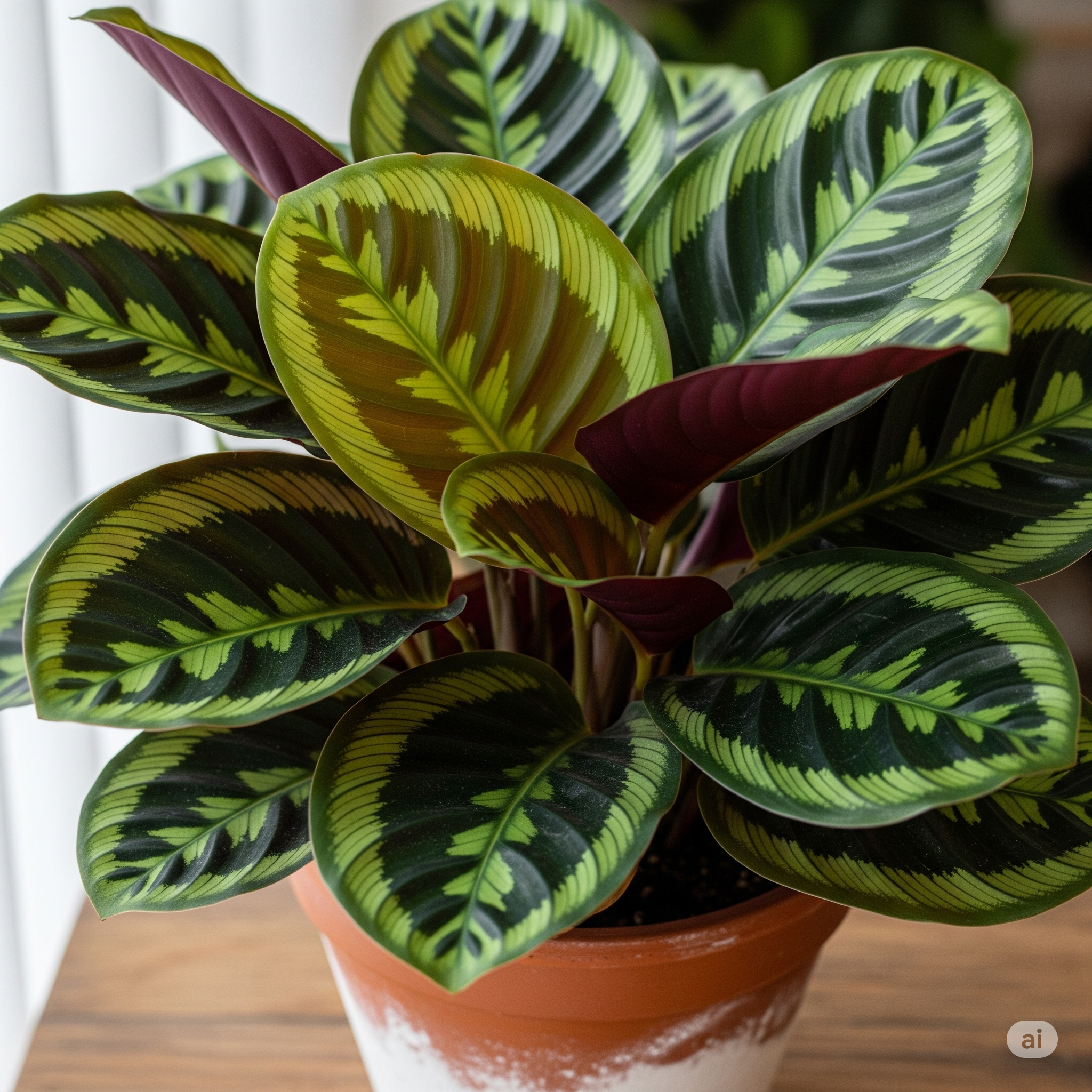Some links on this Website are affiliate links, meaning we may earn a commission if you make a purchase, at no additional cost to you. Please read our full Affiliate Disclosure for more details.
The rubber plant (Ficus elastica) is one of the most loved indoor plants: admired for its large, glossy leaves and bold presence in any space. It’s hardy, elegant, and relatively easy to care for, but one thing that often confuses plant owners is how to water a rubber plant correctly.
Getting the watering routine right is important. Water too much, and you’ll end up with root rot. Water too little, and your plant’s leaves will start to droop or curl. Many houseplant issues can be traced back to inconsistent or improper watering. That’s why understanding rubber plant watering habits is key to keeping your plant healthy and vibrant.
In this article, we’ll take you through everything you need to know about watering your rubber plant, how often to do it, the signs of overwatering and underwatering, and expert tips to make sure your plant thrives year-round.
7 Expert Tips To Care For Lavender Plants In Pots
How To Identify Root Rot In Succulents
How Often Should You Water a Rubber Plant?
There’s no one-size-fits-all answer to how often you should water your rubber plant because it depends on factors like temperature, humidity, light, and pot size. However, the general rule is simple: only water when the top inch of soil feels dry to the touch.
During the growing season (spring and summer), rubber plants actively produce new leaves and need more moisture. You’ll likely need to water about once every 7 to 10 days, but always check the soil first. In fall and winter, growth slows down as the plant enters a semi-dormant phase. At this time, you can water less frequently, roughly every 2 to 3 weeks.
The key is consistency and observation. Rather than following a strict schedule, make it a habit to test the soil with your finger. If the top layer feels dry and crumbly, it’s time to water. If it still feels slightly damp, wait a few more days. This method helps prevent overwatering, which is one of the biggest mistakes new plant owners make.
How to Water Rubber Plant the Right Way

Watering your rubber plant the right way is just as important as knowing when to water it. Many plant owners either give too little water that only moistens the surface or too much water that floods the roots. Both can harm the plant.
Here’s the best step-by-step approach for watering a rubber plant:
- Check the soil moisture. Insert your finger about an inch deep into the soil. If it feels dry, your plant needs water. Or use a moisture meter to measure the amount of moisture present in the soil.
- Water thoroughly. Pour water evenly around the base of the plant until you see it draining from the pot’s bottom holes. This ensures that all roots get moisture.
- Allow excess water to drain out. Always empty the saucer beneath your plant to prevent waterlogging, which can lead to root rot.
- Use room-temperature water. Cold water can shock the plant’s roots, especially during winter.
- Monitor humidity. Rubber plants enjoy moderate humidity levels. If your home is dry, consider occasional misting or using a humidifier.
Remember, rubber plants prefer a balance of moist but never soggy soil. In their natural tropical environment, they’re used to occasional rain followed by periods of drying out. Mimicking this pattern indoors will help your plant stay strong and resilient.
Signs of Overwatering a Rubber Plant

One of the most common rubber plant watering mistakes is overwatering. While many think giving more water is a sign of care, too much can actually suffocate the roots and lead to serious problems.
Here are the main symptoms of an overwatered rubber plant:
- Yellowing leaves, especially near the bottom of the plant
- Droopy or mushy stems
- Soft, blackened roots when you check below the soil
- Mold or fungus growing on the soil surface
- A sour or musty smell from the pot
If your plant shows these signs, stop watering immediately and allow the soil to dry out completely. In severe cases, you may need to remove the plant from its pot, trim away damaged roots, and repot it in fresh, well-draining soil.
Signs of Underwatering a Rubber Plant

While overwatering is more common, underwatering can also weaken your plant over time. The signs are usually more visible on the leaves and overall appearance.
Watch for these symptoms of underwatering:
- Leaves drooping or curling inward
- Brown or crispy edges on leaves
- Dry soil pulling away from the pot
- Slow or stunted growth
When this happens, give your rubber plant a deep soak. Water until it runs out of the drainage holes, and make sure the soil absorbs the moisture evenly. However, don’t start watering too frequently afterward. Allow the soil to dry between watering sessions to avoid creating the opposite problem.
How to Fix Wrinkling Snake Plant Leaves | Causes, Fixes & Prevention
Best Type of Water for Rubber Plants
The type of water you use can also impact the health of your rubber plant. Ideally, use filtered, distilled, or rainwater, as these are free from harsh chemicals like chlorine or fluoride that can build up in the soil and harm your plant over time.
If you must use tap water, it’s best to let it sit overnight before watering. This gives chlorine a chance to evaporate, making it gentler on your plant’s roots. Avoid using cold or extremely hard water, as it can stress the plant and leave unsightly white mineral stains on the leaves and soil surface.
How to Create a Pebble Tray for Your Houseplants
Rubber Plant Watering Tips by Season

Spring and Summer
This is your plant’s active growth period. It will need more frequent watering as it produces new leaves and roots. Keep the soil consistently moist (not soaked), and increase humidity if possible. You can mist the leaves lightly once or twice a week or place the pot on a pebble tray with water to maintain a healthy environment.
Fall and Winter
During cooler months, rubber plants slow down their growth and require less moisture. Reduce your watering schedule and allow the soil to dry more thoroughly between sessions. Avoid misting when it’s cold or if your space is poorly ventilated because excess moisture in cool conditions can encourage fungal problems.
7 Easy Tips For Growing Plants Indoors
What Is The Best Way To Water A Pothos Plant?
Common Watering Mistakes to Avoid
Even with the best intentions, it’s easy to make small mistakes when watering your rubber plant. Here are the most frequent ones to watch out for:
- Watering on a fixed schedule instead of checking the soil’s moisture level
- Using pots without drainage holes, which trap excess water
- Leaving water in the saucer, leading to root rot
- Ignoring changes in season, temperature, or humidity
- Using cold, hard, or untreated tap water
By avoiding these pitfalls, you’ll help your rubber plant grow healthier, with shinier leaves and stronger roots.
FAQs About Watering Rubber Plants
1. Should I mist my rubber plant?
Yes. Misting helps increase humidity, especially during dry months. However, mist lightly — too much moisture on the leaves can attract pests or cause fungal issues.
2. Can I use tap water for my rubber plant?
You can, but it’s best to let it sit overnight so the chlorine can evaporate. Filtered or rainwater is always a safer choice for long-term health.
3. How do I know when my rubber plant needs water?
Check the top inch of soil. If it’s dry to the touch, it’s time to water. Also, pay attention to droopy or slightly curling leaves, which often signal thirst.
4. Why are my rubber plant leaves turning yellow?
Yellowing leaves usually mean your plant is getting too much water. Allow the soil to dry out completely before watering again and ensure your pot has drainage holes.
5. How can I prevent root rot in my rubber plant?
Use well-draining soil, make sure the pot has drainage holes, and never let your plant sit in standing water. Adjust your watering schedule with the seasons.
15 Moisture Absorbing Bathroom Plants That Keep Your Space Fresh and Mold-Free


